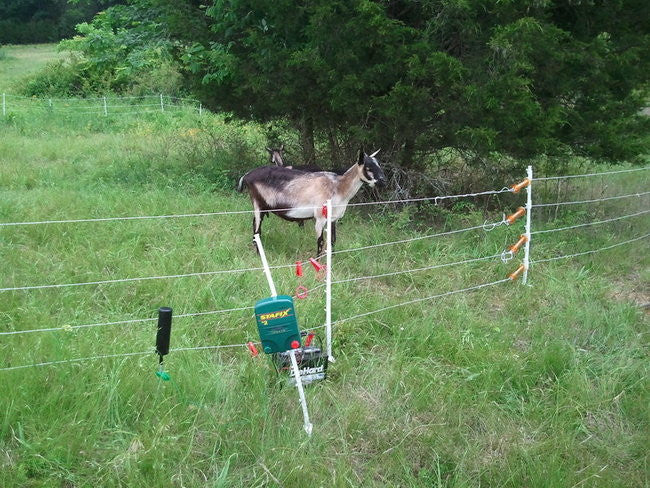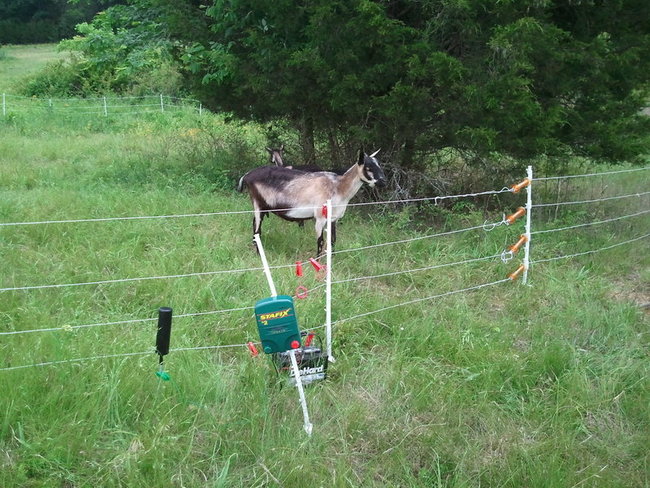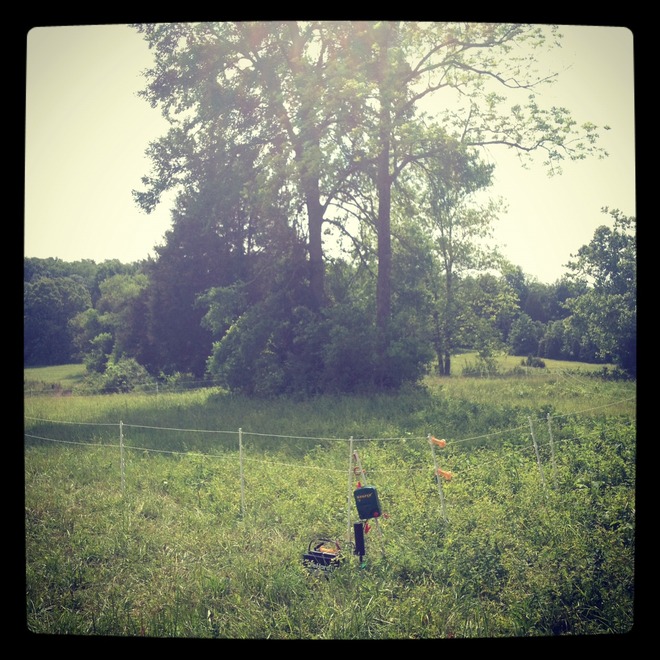
Since we started putting the goats out on pasture we’ve received a surprising amount of interest about the method we’re using. I certainly don’t think it’s the best method, but it works for us right now and over time I’m sure it will change a lot. In fact, we’ve already made a number of changes since we first started a couple weeks ago.
Preparing for the Goats on Pasture
The first step was to get everything ready. This took several weeks. That’s why the goats had the Temporary Goat House and adjacent outdoor holding area. On the agenda was perimeter fencing, interior electric fencing, reliable guard dogs and assurance that our pasture was fit for goat consumption.
We’ve written a bit about the livestock guardian dogs, so I’ll skip that for now and focus on the electric fencing and the forages.
For the electric we use a pretty basic set-up. It’s four strands of polywire with the lower strands spaced closer together and higher strands farther apart. We haven’t measured the exact distances, more just eye-balling it for what we think will work. We use plastic step-in posts to string up the wire with two step-in posts at an angle for the corners. For the juice we use a Stafix X2 energizer to power the wire and a deep cycle marine battery from Sears to power the energizer. Once you get it all together it’s pretty simple. The pain in the butt part is moving it everyday.
Since the goats require four wires (although we might get bold and try three) you have to reel them all up (we do two at a time on one reel) and then pull out the step-in posts and then set it all up over again. Honestly, we’re not too efficient at this part and longer term it’s not a sustainable system. Eventually we’ll either need to make bigger paddocks for the goats or install permanent cross-fencing that can carry a current and then tie everything off that. For now though, it works.
 Mayday and Sabine getting ready to move to a new paddock
Mayday and Sabine getting ready to move to a new paddock
Getting the Goats to Respect the Fence
Before we put the goats in the electrically fenced paddock we made sure they knew that testing the electric fence wasn’t a good idea. We didn’t want them to be inside the fence without any idea what it was and figure out that they could just jump over it (or through it) and be fine on the other side. They needed to respect the fence. So we coaxed them into it and let them get zapped. It wasn’t fun, but I think it worked. It’s really not a bad zap, but it does catch you off guard. It’s not something that I do on purpose too frequently, although I am the resident fence tester. The dogs had to learn the hard way too and boy do they hate the fence.
So far everyone respects it for the most part. There’s always an escapee or two (just check our Facebook page for Sabine's latest antic), but usually they just want to eat whatever is right on the other side and they’re not too interested in running really far away. The dogs, on the other hand, if they escape they want to run around the whole perimeter and pee on everything and bark at everything and THEN they come back and ask for a belly rub. That’s ok as long as the sun isn’t about to set, then it gets a little nerve-wracking, but luckily with three of them we don’t have to worry much as long as one is inside with the goats.
Determining Paddock Size
The paddocks we set up vary in size based on what’s in the particular area we are grazing that day. Usually it’s about a quarter of an acre for our 6 kids, one yearling and two does. For all the grazing people out there it works out to about 2-3 animal units/acre, with an animal unit being 1,000# of animal. With our marginal land situation right now that’s about the stocking rate we’re aiming for. Over time we’d like to plant for more goat-specific forages and cater the land to their stomach’s desires, but for now that should work about right. After years of neglect our land is actually in pretty good shape for goats. Lots of multi-flora rose, buckbush, briars, lespedeza, honeysuckle, and all kinds of other stuff that cows wouldn't even touch! For our land, the ultimate goal is a stocking rate of 4-5 animal units/acre, but that will take at least 3-5 yrs and probably longer.
So why the heck do we go through all this trouble? That’s to come in a later post.



